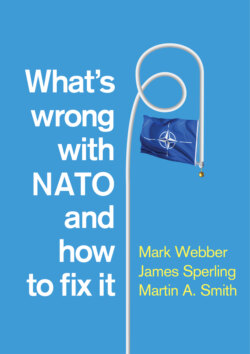Читать книгу What's Wrong with NATO and How to Fix it - Mark Webber - Страница 23
NATO as an Institution
ОглавлениеNATO has displayed a feature common among complex organizations: that of ‘mission creep’ or ‘competence creep’.15 Scholars looking at this phenomenon have often attributed it to the power of organizational bureaucracies.16 This is not really relevant in NATO’s case: its administrative cadre is too small and the power of the allies too great. As we shall see below, it is the allies who have loaded NATO with increased responsibilities. But why has the Alliance been susceptible to these demands in the first place? An important part of the answer here lies in the ‘institutional assets’ referred to in the introductory chapter. In general, institutional survival and continuity require adaptation to external circumstances: striking a ‘balance between exploring new possibilities and exploiting existing capabilities’.17 In NATO’s case, there have certainly been ample opportunities for repurposing. The Alliance’s traditional mission has not gone away, as evident in the tense relationship with Russia, but in addition it has had to deal with myriad other problems: identity-based violence, terrorism, pandemics, environmental degradation, food shortages, organized crime, cyber attacks and large migration flows. During the Cold War, such issues were side-lined by the imperative of superpower competition. The Soviet Union’s demise along with the acceleration of globalization has dissolved that suppressant. The upshot has been the spread of ‘a variety of threats […] global in scope […] more serious in their effects [and] inherently more difficult to measure, locate, monitor and contain’.18 In this world of uncertainty, the very notion of ‘threat’ for some has lost its relevance. It is rather ‘risks’, unbound by time or space, that have proliferated. Risks cannot be eliminated, only managed, and bodies such as NATO have had to engage accordingly in an unending task of risk management.19 Doing so has not turned the Alliance into a general-purpose organization akin to the UN or regional bodies such as the EU, the African Union or the Association of Southeast Asian Nations (ASEAN). NATO’s political, scientific and other functions remain very much secondary to its security imperative. And here, it possesses a number of distinct advantages.
First, NATO has an authoritative legal basis in the shape of the North Atlantic Treaty. It is not unique among international organizations in this regard – just think of the Treaties of the European Union or the European Convention on Human Rights of the Council of Europe. But the NATO treaty has the benefit of concision (it is a mere fourteen articles long) and flexibility. Its key provisions – Article 5 on collective defence and Article 10 on the admission of new members – are open to interpretation, but precisely because of this, according to James Goldgeier, they ‘provided the alliance with its purpose and scope’ during the Cold War and have ‘enabled [it] to move forward in the decades [since]’.20
Second, NATO is the location of unrivalled command and force structures. During the Cold War, it met its match in the Warsaw Pact, but that body disappeared in 1991. Contemporary multinational alliances (the Russian-led Collective Security Treaty Organization, for example) have integrated military structures, and international organizations such as the EU, the OSCE and the UN have military and civilian bodies that oversee the tasks of peacekeeping and conflict management. But none of these come close to NATO’s sophistication and scope. The Alliance is possessed of two strategic commands based on either side of the Atlantic: Allied Command Operations (ACO) in Mons, Belgium, and Allied Command Transformation (ACT) in Norfolk, Virginia. These sit above a number of multinational headquarters at the ‘operational and component levels of command, distributed geographically and commonly funded’.21 Since the early 1990s, NATO’s command structures have been refashioned several times as well as being subject to a significant downsizing of personnel. Nonetheless, they have proven both resilient and adaptable – illustrated most recently by decisions in 2018 to establish two new Joint Commands and a Cyberspace Operations Centre. NATO’s force structures, meanwhile, consist of air, land, maritime and special operations forces and local headquarters held by allies (individually or in multinational format) available for assignment to NATO’s Supreme Allied Commander Europe (SACEUR), the commanding officer of SHAPE located at ACO. Taken together, command and force structures oversee NATO operations, force deployments and exercises. They are complemented by an array of integrated military resources (air and ballistic missile defence, an airborne warning and control system or AWACS, alliance ground surveillance, joint intelligence, surveillance and reconnaissance), training and educational establishments (the NATO-accredited Centres of Excellence, the NATO Defence College and NATO School) and specialized agencies (on science and technology, security of communications, standardization and procurement).
Third, NATO is characterized by robust force generation and defence planning processes. The former has had to keep pace with the growing number of NATO missions and the increased number of allies and partners participating in them. The latter, meanwhile, has had to accommodate NATO’s enlarged membership and increasingly complex capability requirements. But both processes, Christian Tuschhoff has shown, ‘have been confirmed, refined, and enhanced by continuing practice’.22
While we have highlighted the accumulation of tasks as a problem, NATO at least has the institutional wherewithal to absorb them. But that has become a problem in itself. NATO’s institutional flexibility has meant it has been less than discriminate in the tasks it has taken on. It has become the ‘garbage can’ into which allies dispose all manner of problems confronting them.23
